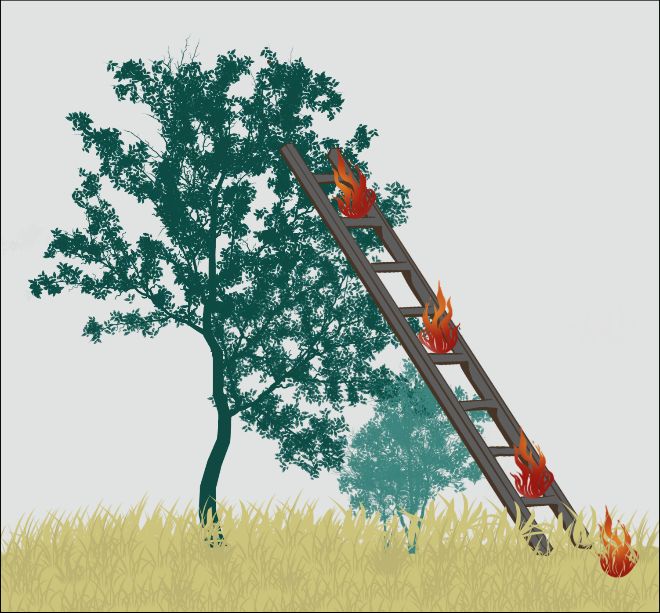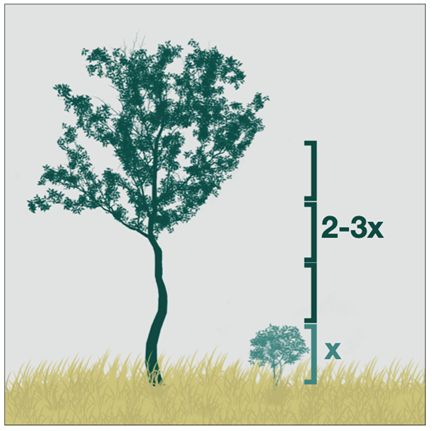Being “firewise” means using the principles of firewise planning to safely live in the wildland-urban interface. This publication reviews the principle of selecting and maintaining low- to moderate-flammability shrubs for your landscaping.
Living in the wildland-urban interface (WUI) provides an excellent opportunity to enjoy outdoor scenery, such as surrounding forests, wildflowers, and wildlife. Shrubs can be an attractive element in wildland-urban landscaping, providing beauty when in flower or fruit and serving as important food and cover for wildlife. However, some shrubs can put your home in danger, especially in areas with moderate to high fire risk. This publication provides information to homeowners, developers, and individuals seeking to reduce wildfire risk by planting and maintaining firewise plants.
Different types of shrubs respond to fire differently. Some shrubs ignite faster when exposed to a flame, burn at higher temperatures, and continue burning longer than less flammable species. Flammability components can be related to visible characteristics of the plant, such as its leaf shape and branching patterns. For example, wide, flat, succulent leaves tend to be less flammable than small needles. Other characteristics that contribute to a shrub’s flammability are not so easy to detect by visually inspecting a shrub. Branches and leaves differ in how much water they hold, affecting how they burn. Some shrubs contain unique oils, resins, or other chemical traits that affect their flammability. For more information about the characteristics that determine a plant’s flammability, see the publication “Fire in the Wildland-Urban Interface: Selecting and Maintaining Firewise Plants for Landscaping” at https://edis.ifas.ufl.edu/publication/FR147.
Common landscaping shrubs were grouped into high, moderate, and low flammability categories by researchers from the USDA Forest Service Southern Research Station, UF/IFAS School of Forest, Fisheries, and Geomatics Sciences, and the National Institute of Standards and Technology. A colorful, illustrated guide presents 34 species by flammability category to help homeowners select shrubs for landscaping to minimize wildfire risk. The full-length guide is available at: https://urbanforestrysouth.org/products/fact-sheets/fire-in-the-interface-fact-sheets/selecting-firewise-shrubs-to-reduce-wildfire-risk/index_html. There is also a quick guide to selecting firewise shrubs available at: https://urbanforestrysouth.org/products/fact-sheets/fire-in-the-interface-fact-sheets/quick-guide-to-firewise-shrubs/index_html
A Spanish language version is available at: https://urbanforestrysouth.org/products/fact-sheets/fire-in-the-interface-fact-sheets_es/guia-rapida-de-arbustos-resistentes-al-fuego/index_html
Of the 34 common shrub species that were tested, 22 have low flammability and are appropriate for firewise lists and planting near homes. The eight shrub species identified as moderately flammable should be cautiously planted in the defensible space around a home. The four shrub species identified as highly flammable can ignite quickly and release large quantities of heat even when healthy and well-watered and are thus not recommended for planting near homes.
Homeowners should know that evenlow-flammability,firewise plants may be more flammable during droughts or other extreme fire conditions. It is never advised to plant shrubs, even those with low flammability, against structures or homes (Figure 1).
All shrubs within the defensible space, defined as a minimum of 100 feet from structures, should be routinely maintained. Dead or diseased plant material should be removed, and shrubs should be pruned to ensure they are not acting as ladder fuels that connect ground fuels to surrounding treetops (Figure 2). Some shrubs can grow as tall as trees and pose a greater danger to homes if they are not pruned. Ideally, the distance from understory to overstory fuels should be at least 2–3 times the height of the understory fuels (Figure 3).

Credit: Raelene M. Crandall, UF/IFAS

Credit: Raelene M. Crandall, UF/IFAS

Credit: Raelene M. Crandall, UF/IFAS
The best time to prune flowering shrubs is shortly after they finish flowering, which will ensure you have ample flowers the following year. Also, try to complete heavy pruning outside of the nesting season, which peaks in Florida during May and June, to help minimize impacts on the birds and other wildlife that frequent the wildland-urban interface.
Other Fact Sheets in the "Fire in the Wildland-Urban Interface" Series
https://urbanforestrysouth.org/products/fact-sheets
- Considering Fire in Florida's Ecosystems
- Preparing a Firewise Plant List for WUI Residents
- Reducing Wildfire Risk While Achieving Other Landscaping Goals
- Selecting and Maintaining Firewise Plants for Landscaping
- Understanding Fire Behavior
These fact sheets can also be found on the UF/IFAS Extension's EDIS website: https://edis.ifas.ufl.edu/topic_series_fire_in_the_wildland_urban_interface